
|
|
FYBUSH.COM/SITE OF THE WEEK
NEEDS YOUR SUPPORT! (AND YOU CAN GET A FREE TOWER SITE CALENDAR
IF YOU PLEDGE NOW...) CLICK HERE TO
LEARN MORE...
October 16-23, 2003
KYW, WFIL and WIBG/WZZD, Philadelphia
As exciting as Philadelphia's Roxborough tower farm is (check out part one and part two of our two-part visit if you haven't already), there's much more awaiting the intrepid tower hunter just a few miles to the west.
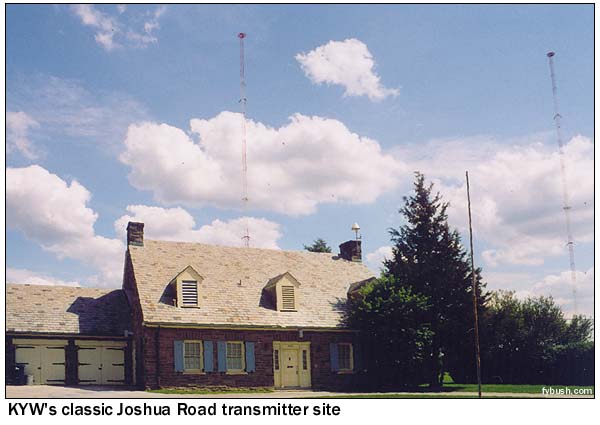
Cross the Philadelphia city line as you head out Ridge Pike and turn right on Joshua Road and you'll find yourself in the heart of a nice suburb called Whitemarsh Township - and just a couple of miles up Joshua you'll find the two-tower site of one of Philadelphia's most famous radio stations.
This is KYW, 50,000 big watts on 1060, and it's taken one heck of a journey to get here. The KYW callsign first showed up on the radio in Chicago way back in 1921 as one of Westinghouse's first stations, operated in partnership with electrical mogul Samuel Insull and the Chicago Civic Opera. (Legend has it that the first words spoken on KYW's inaugural broadcast, by a diva walking on stage at the opera, were "It's dark in here!")
KYW was far less successful than its sister stations KDKA and WBZ, perhaps due in part to the intense radio competition in the Windy City, and perhaps due to political struggles that kept it from winning a stable spot on the dial. The Federal Radio Commission's attempt to balance the number of clear channels in different regions of the country eventually resulted in KYW's 1020 kc spot being assigned to the mid-Atlantic region and competing applications for the frequency coming in from Detroit's WWJ, Pittsburgh's WJAS and even Philadelphia's WCAU. In an attempt to hang on to 1020, KYW itself applied to move to Philadelphia, and in 1934 it shut down its Chicago operations and relocated to Joshua Road, building a four-tower antenna system out of steel poles mounted atop wooden bases. (I believe, but am not certain, that these supported a horizontal wire antenna.)
In 1941, KYW increased power from 10 to 50 kilowatts and then made the NARBA move to 1060, and in 1949 it replaced the four-tower antenna system with the two 450' Ideco top-loaded towers still in use. At the time, KYW's directional pattern provided useful coverage of the entire Philadelphia market even as it protected adjacent-channel WHN (1050) in New York; the suburban growth outside the pattern, deep into New Jersey and up into Bucks County, would come later.
And in 1957, as we recounted last week, NBC's pressure on Westinghouse resulted in a swap of Westinghouse's Philadelphia properties for NBC's Cleveland operation. The KYW calls moved to the former WTAM in Cleveland and Joshua Road became home to WRCV. Eight years later, the forced swap was reversed and the KYW calls came home to Philadelphia for good, at which point the station became the first adopter of Westinghouse's new all-news format, which it's still running to this day, teletype sound effects and all.
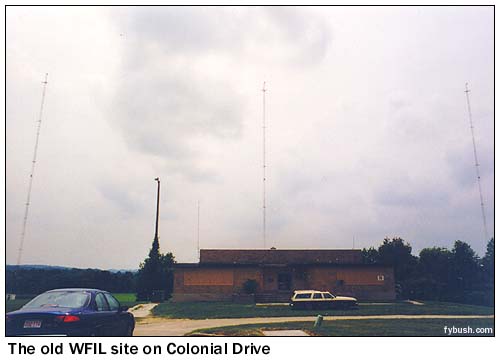 Less than a mile
away on Colonial Drive, the three towers you see at the left
(actually, three self-supporters that were replaced by those
guyed towers in the mid-eighties) pumped out the programming
Philadelphia teens were listening to while their parents tuned
in KYW.
Less than a mile
away on Colonial Drive, the three towers you see at the left
(actually, three self-supporters that were replaced by those
guyed towers in the mid-eighties) pumped out the programming
Philadelphia teens were listening to while their parents tuned
in KYW.
This was WFIL, 5000 big watts down at the bottom of the dial at 560, owned by Walter Annenberg's Triangle Broadcasting, and it arrived out here in Whitemarsh Township sometime in the late 1940s. It would be another two decades - September of 1966, to be precise - before the sleepy middle-of-the-road WFIL would be reborn as "Famous 56," soon to be the number one station in Philadelphia through the late sixties and most of the seventies.
The eighties and nineties were less kind to WFIL. AC, country and a return to oldies were tried and failed. The station was sold and lost its heritage calls, becoming WEAZ(AM) and simulcasting beautiful music WEAZ-FM 101.1, then continuing with easy listening as "Wish 560" after the FM broke away, then changing calls to WBEB and simulcasting the FM again.
Religious broadcaster Salem Communications bought 560 in 1994, changing the calls to WPHY and then back to WFIL and installing a religious talk format there. And then, in the late nineties, the transmitter site went up for sale as plans were laid to move 560 to a diplex on the nearby transmitter site of Salem sister station WZZD.
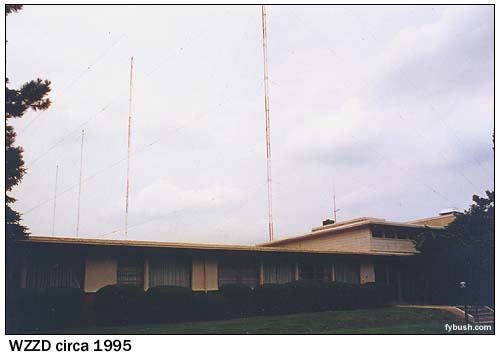 WZZD's 990 spot
on the dial had a magnificent history of its own. WIBG began
in the twenties as a religious station running low power from
St. Paul's Episcopal Church in suburban Elkins Park. Under Storer's
ownership in the fifties, it moved out to Ridge Pike, almost
within sight of the WFIL site, put up a five-tower array, cranked
day power up to 50 kilowatts and began pumping out top 40 as
the legendary "Wibbage," with names like Hy Lit, Joe
Niagara and Jerry Stevens screaming across the dial.
WZZD's 990 spot
on the dial had a magnificent history of its own. WIBG began
in the twenties as a religious station running low power from
St. Paul's Episcopal Church in suburban Elkins Park. Under Storer's
ownership in the fifties, it moved out to Ridge Pike, almost
within sight of the WFIL site, put up a five-tower array, cranked
day power up to 50 kilowatts and began pumping out top 40 as
the legendary "Wibbage," with names like Hy Lit, Joe
Niagara and Jerry Stevens screaming across the dial.
(WIBG-FM on 94.1 was here as well, simulcasting WIBG and running less than full class B power to protect co-channel WKOK-FM in Sunbury. Storer shut down the FM in 1968 and eventually sold the station, which returned in 1971 as legendary rocker WYSP and soon moved off the 990 towers to nearby Roxborough.)
The advent of "Famous 56" set up a rivalry with the "Big 99" that lasted more than a decade. In September 1977, WIBG changed calls to WZZD and was reborn as "Wizzard 100," an attempt to compete with the growing crowd of FM music stations in town. It lasted only three years before WZZD was sold and flipped to religious programming.
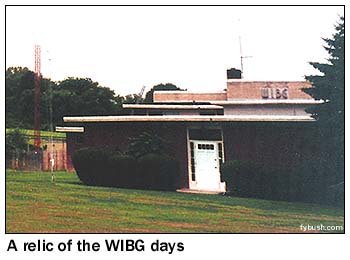 (As you can see at
left, the change of calls couldn't completely obscure 990's heritage
- that WIBG emblem on the building was obscured for a while by
other signage but eventually re-emerged.)
(As you can see at
left, the change of calls couldn't completely obscure 990's heritage
- that WIBG emblem on the building was obscured for a while by
other signage but eventually re-emerged.)
WZZD tweaked its religious format over the years, eventually going to contemporary Christian music and in time segueing to the mixture of religious preaching and music that it now plays.
WZZD had also tweaked its directional pattern by the time we arrived to photograph it in the summer of 1995, eliminating the fifth tower that was at the far end of the array from the studio/transmitter building.
The addition of WFIL to the WZZD site a few years later meant the addition of two new towers at an angle to the existing 990 array, with 990 continuing to use its original four towers and 560's new three-tower in-line array using the two new towers and WZZD's tower #4, the one closest to the transmitter building.
The operation appears to have been a success; both 560 and 990 seem to get out even better now than they did in the days when they had separate transmitter sites. The old WFIL site met the wrecking ball a few years back, and today its 47 acres are split between Whitemarsh Township's new McCarthy park and playing fields for the local schools.
Did anyone at Salem appreciate the irony of uniting these two old rivals on the same set of towers? We sure hope so.
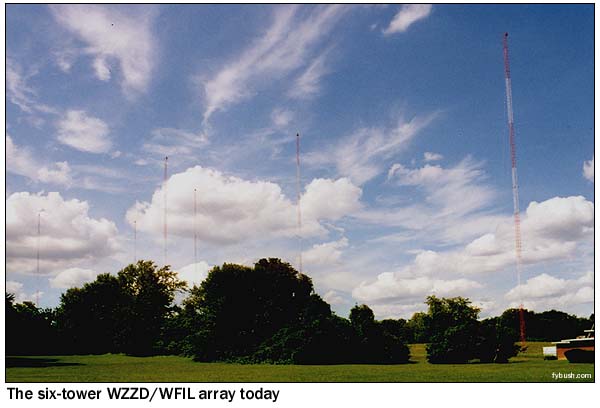
Tower Site Calendar 2004 is NOW AVAILABLE! Click here for advance ordering information!
- Previous Site of the Week: Roxborough Tower Farm, Philadelphia (part II)
- Next Week: A Repeat Visit to 4 Times Square
- Site of the Week INDEX!
- How can you help support Site of the Week? Click here!
- Submit your suggestions for a future Site of the Week!
